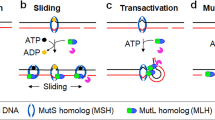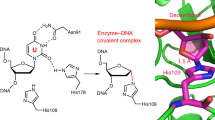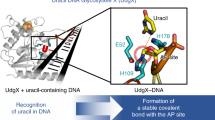Abstract
Escherichia coli MutY has an important role in preventing mutations associated with the oxidative lesion 7,8-dihydro-8-oxo-2′-deoxyguanosine (OG) in DNA by excising adenines from OG·A mismatches as the first step of base excision repair. To determine the importance of specific steps in the base pair recognition and base removal process of MutY, we have evaluated the effects of modifications of the OG·A substrate on the kinetics of base removal, mismatch affinity and repair to G-C in an E. coli–based assay. Notably, adenine modification was tolerated in the cellular assay, whereas modification of OG resulted in minimal cellular repair. High affinity for the mismatch and efficient base removal required the presence of OG. Taken together, these results suggest that the presence of OG is a critical feature that is necessary for MutY to locate OG·A mismatches and select the appropriate adenines for excision to initiate repair in vivo before replication.
This is a preview of subscription content, access via your institution
Access options
Subscribe to this journal
Receive 12 print issues and online access
$259.00 per year
only $21.58 per issue
Buy this article
- Purchase on Springer Link
- Instant access to full article PDF
Prices may be subject to local taxes which are calculated during checkout



Similar content being viewed by others
Accession codes
References
Iyer, R.R., Pluciennik, A., Burdett, V. & Modrich, P.L. DNA mismatch repair: functions and mechanisms. Chem. Rev. 106, 302–323 (2006).
Su, S.-S., Lahue, R.S., Au, K.G. & Modrich, P. Mispair specificity of methyl-directed DNA mismatch correction. J. Biol. Chem. 263, 6829–6835 (1988).
Lu, A.-L. & Chang, D.-Y. Repair of single base-pair transversion mismatches of Escherichia coli in vitro: correction of certain A/G mismatches is independent of dam methylation and host mut HLS gene functions. Genetics 118, 593–600 (1988).
Radicella, J.P., Clark, E.A. & Fox, M.S. Some mismatch repair activities in Escherichia coli. Proc. Natl. Acad. Sci. USA 85, 9674–9678 (1988).
Nghiem, Y., Cabrera, M., Cupples, C.G. & Miller, J.H. The mutY gene: A mutator locus in Escherichia coli that generates G:C to T:A transversions. Proc. Natl. Acad. Sci. USA 85, 2709–2713 (1988).
Au, K.G., Cabrera, M., Miller, J.H. & Modrich, P. Escherichia coli mutY gene product is required for specific AG to CG mismatch correction. Proc. Natl. Acad. Sci. USA 85, 9163–9166 (1988).
Au, K.G., Clark, S., Miller, J.H. & Modrich, P. Escherichia coli mutY gene encodes an adenine glycosylase active on G-A mispairs. Proc. Natl. Acad. Sci. USA 86, 8877–8881 (1989).
Lu, A.-L. & Chang, D.-Y. A novel nucleotide excision repair for the conversion of an A/G mismatch to C/G base pair in E. coli. Cell 54, 805–812 (1988).
David, S.S. & Williams, S.D. Chemistry of glycosylases and endonucleases involved in base-excision repair. Chem. Rev. 98, 1221–1261 (1998).
David, S.S., O'Shea, V.L. & Kundu, S. Base-excision repair of oxidative DNA damage. Nature 447, 941–950 (2007).
Sung, J.-S. & Demple, B. Roles of base excision repair subpathways in correcting oxidized abasic sites in DNA. FEBS J. 273, 1620–1629 (2006).
Michaels, M.L. & Miller, J.H. The GO system protects organisms from the mutagenic effect of the spontaneous lesion 8-hydroxyguanine (7,8-dihydro-8-oxoguanine). J. Bacteriol. 174, 6321–6325 (1992).
Michaels, M.L., Tchou, J., Grollman, A.P. & Miller, J.H. A repair system for 8-oxo-7,8-dihydrodeoxyguanosine. Biochemistry 31, 10964–10968 (1992).
Michaels, M.L., Cruz, C., Grollman, A.P. & Miller, J.H. Evidence that MutY and MutM combine to prevent mutations by an oxidatively damaged form of guanine in DNA. Proc. Natl. Acad. Sci. USA 89, 7022–7025 (1992).
Al-Tassan, N. et al. Inherited variants of MYH associated with somatic G:C to T:A mutations in colorectal tumors. Nat. Genet. 30, 227–232 (2002).
Sampson, J.R., Jones, S., Dolwani, S. & Cheadle, J.P. MutYH (MYH) and colorectal cancer. Biochem. Soc. Trans. 33, 679–683 (2005).
Porello, S.L., Leyes, A.E. & David, S.S. Single-turnover and pre-steady-state kinetics of the reaction of the adenine glycosylase MutY with mismatch-containing DNA substrates. Biochemistry 37, 14756–14764 (1998).
Francis, A.W., Helquist, S.A., Kool, E.T. & David, S.S. Probing the requirements for recognition and catalysis in Fpg and MutY with nonpolar adenine isosteres. J. Am. Chem. Soc. 125, 16235–16242 (2003).
Chmiel, N.H., Golinelli, M.-P., Francis, A.W. & David, S.S. Efficient recognition of substrates and substrate analogs by the adenine glycosylase MutY requires the C-terminal domain. Nucleic Acids Res. 29, 553–564 (2001).
McCann, J.A.B. & Berti, P.J. Adenine release is fast in MutY-catalyzed hydrolysis of G:A and 8-oxo-G:A DNA mismatches. J. Biol. Chem. 278, 29587–29592 (2003).
Pope, M.A., Porello, S.L. & David, S.S. E. coli AP endonucleases enhance the turnover of the adenine glycosylase MutY with G:A substrates. J. Biol. Chem. 277, 22605–22615 (2002).
Pope, M.A. & David, S.S. DNA damage recognition and repair by the murine MutY homologue. DNA Repair (Amst.) 4, 91–102 (2005).
Hang, B. & Singer, B. Protein-Protein interactions involving DNA glycosylases. Chem. Res. Toxicol. 16, 1181–1195 (2003).
Fromme, J.C., Banerjee, A., Huang, S.J. & Verdine, G.L. Structural basis for removal of adenine mispaired with 8-oxoguanine by MutY adenine DNA glycosylase. Nature 427, 652–656 (2004).
Chmiel, N.H., Livingston, A.L. & David, S.S. Insight into the functional consequences of inherited variants of the hMYH adenine glycosylase associated with colorectal cancer: complementation assays with hMYH variants and pre-steady-state kinetics of the corresponding mutated E. coli enzymes. J. Mol. Biol. 327, 431–443 (2003).
Pearson, C.G., Shikazono, N., Thacker, J. & O'Neill, P.O. Enhanced mutagenic potential of 8-oxo-7,8-dihydroguanine when present within a cluster DNA damage site. Nucleic Acids Res. 32, 263–270 (2004).
Shikazono, N., Pearson, C., O'Neill, P.O. & Thacker, J. The roles of specific glycosylases in determining the mutagenic consequences of clustered DNA base damage. Nucleic Acids Res. 34, 3722–3730 (2006).
Zhao, J. & Winkler, M.E. Reduction of the GC to TA transversion mutation by overexpression of MutS in E. coli K-12. J. Bacteriol. 182, 5025–5028 (2000).
Bai, H. & Lu, A.-L. Physical and functional interactions between Escherichia coli MutY glycosylase and mismatch repair protein MutS. J. Bacteriol. 189, 902–910 (2007).
Berti, P.J. & McCann, J.A.B. Toward a detailed understanding of base excision repair enzymes: transition state and mechanistic analyses of N-glycoside hydrolysis and N-glycoside transfer. Chem. Rev. 106, 506–555 (2006).
Chepanoske, C.L., Porello, S.P., Fujiwara, T., Sugiyama, H. & David, S.S. Investigation of substrate recognition by E. coli MutY using substrate analogs. Nucleic Acids Res. 27, 3197–3204 (1999).
Golinelli, M.-P., Chmiel, N.H. & David, S.S. Site-directed mutagenesis of the cysteine ligands to the [4Fe-4S] cluster of Escherichia coli MutY. Biochemistry 38, 6997–7007 (1999).
Bai, H. et al. Functional characterization of two human MutY homolog (hMYH) missense mutations (R227W and V232F) that lie within the putative hMSH6 binding domain and are associated with hMYH polyposis. Nucleic Acids Res. 33, 597–604 (2005).
Miller, J.H. A Short Course in Bacterial Genetics 193–211 (Cold Spring Harbor Laboratory Press, Cold Spring Harbor, New York, USA, 1992).
Wehrli, W., Knusel, F., Schmid, K. & Staehlin, M. Interaction of rifamycin with bacterial RNA polymerase. Proc. Natl. Acad. Sci. USA 61, 667–673 (1968).
Livingston, A.L., Kundu, S., Henderson-Pozzi, M., Anderson, D.W. & David, S.S. Insight into the roles of tyrosine 82 and glycine 253 in the Escherichia coli adenine glycosylase MutY. Biochemistry 44, 14179–14190 (2005).
Record, M.T., Ha, J.-H. & Fisher, M.A. Analysis of equilibrium and kinetic measurements to determine thermodynamic origins of stability and specificity and mechanism of formation of site-specific complexes between proteins and helical DNA. Methods Enzymol. 208, 291–343 (1991).
Bernards, A.S., Miller, J.K., Bao, K.K. & Wong, I. Flipping duplex DNA inside out: a double base-flipping reaction mechanism by Escherichia coli MutY adenine glycosylase. J. Biol. Chem. 277, 20960–20964 (2002).
Porello, S.L., Williams, S.D., Kuhn, H., Michaels, M.L. & David, S.S. Specific recognition of substrate analogs by the DNA mismatch repair enzyme MutY. J. Am. Chem. Soc. 118, 10684–10692 (1996).
Pope, M.A., Chmiel, N.H. & David, S.S. Insight into the functional consequences of hMYH variants associated with colorectal cancer: distinct differences in the adenine glycosylase activity and the response to AP endonuclease of Y150C and G365D murine MYH. DNA Repair (Amst.) 4, 315–325 (2005).
Maki, A.S., Kim, T. & Kool, E.T. Direct comparisons of A-strand and T-strand minor groove interactions in DNA curvature at A tracts. Biochemistry 43, 1102–1110 (2004).
Sambrook, J. & Maniatis, T. Molecular Cloning: a Laboratory Manual, 1.33–1.75 (Cold Spring Harbor Press, Cold Spring Harbor, New York, USA, 1989).
Acknowledgements
We thank B. Wilcock, S. Kundu and M.A. Pope for technical assistance. We also thank M. Marinus (University of Massachusetts) for providing the AB1157, GM7724 (mutY::Cam) and KM75 (mutS465::Tet) E. coli strains. J. Miller and M. Michaels (University of California, Los Angeles) provided the pKKYEco plasmid and JM101 (mutY−) E. coli strain. This work was supported by US National Institutes of Health (NIH) grants to S.S.D. (CA67985) and E.T.K. (GM072705), and by NIH predoctoral traineeships to A.L.L. (GM08537) and V.L.O. (GM08537 and CA093247). The DNA sequencing facility at the University of Utah Medical School is supported in part by an NIH National Cancer Institute grant (5P30CA43014).
Author information
Authors and Affiliations
Contributions
A.L.L., V.L.O. and S.S.D. designed the experiments. A.L.L. and V.L.O. performed the experiments. T.K. synthesized the Z3-containing duplex 2 oligonucleotide. S.S.D. and E.T.K. supervised all experiments. A.L.L., V.L.O. and S.S.D. wrote the manuscript. E.T.K. read and made comments on the manuscript.
Corresponding author
Supplementary information
Supplementary Text and Figures
Supplementary Figure 1 and Supplementary Methods (PDF 230 kb)
Rights and permissions
About this article
Cite this article
Livingston, A., O'Shea, V., Kim, T. et al. Unnatural substrates reveal the importance of 8-oxoguanine for in vivo mismatch repair by MutY. Nat Chem Biol 4, 51–58 (2008). https://doi.org/10.1038/nchembio.2007.40
Received:
Accepted:
Published:
Issue Date:
DOI: https://doi.org/10.1038/nchembio.2007.40



